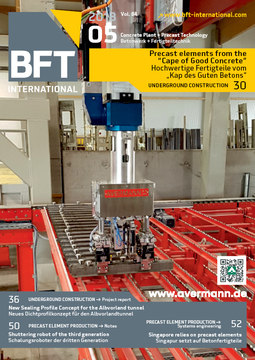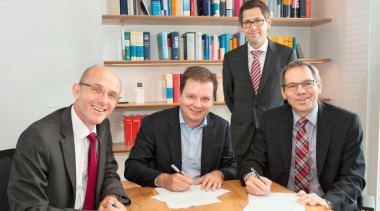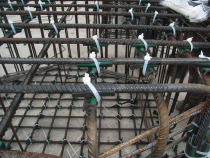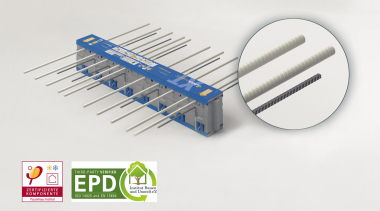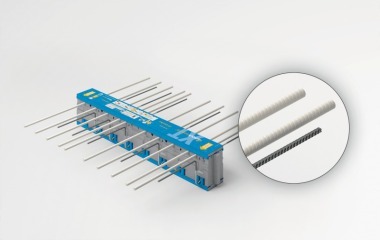Joint Venture promotes ongoing development of glass fiber technology
Specialized solutions are needed for satisfying special reinforcement requirements. The use of electrically nonconductive, corrosion-resistant, thermally-insulating reinforcement that is resistant to chemical attack is particularly needed in tunnel construction, tram systems, electricity infrastructure, and research institutions. Reinforcing steel alone cannot satisfy these requirements. Combar glass fiber reinforcement is the superior alternative and is especially able to meet such requirements. The joint venture entered into in 2017 between the manufacturer of construction products, Schöck, and Fiberline Composites A/S, has served as development lever for glass fiber reinforced synthetic reinforcement.
The process for the manufacture of Combar consists of two steps and is optimized to meet the requirements of these reinforcing bars. In the first step, high-strength glass fibers are densely bundled and pulled through a tool that encases them with synthetic resin. This process is called Pultrusion. The second step, profiling, comprises cutting of the ribs in the hardened bars and application of final coating. The result of this process, according to the manufacturer, is a reinforcing material with unique properties.
High tensile strength and durability
The composite material of glass fibers possesses the outstanding tensile strength of far greater than 1,000 N/mm². The strength achieved in short-term tensile strength is double that of conventional reinforcing steel. The reason for this high tensile strength is the high fiber content and the linear, parallel orientation of the fibers. Moreover, 75 % of the volume (88 % by weight) consists of glass. The vinyl-ester resin that envelopes the glass fiber further contributes to its tensile strength and makes it extremely corrosion-resistant and non-permeable.
Another characteristic property of composite glass fiber material is its high durability. Combar has been approved for durable use in structurally relevant concrete construction for many years. During approval tests, a value of 580 N/mm² was determined as long-term tensile strength for Combar. The 1.3 material factor specified in Germany for Combar results in a design tension of 445 N/mm². These values apply to all applications and to service life of 100 years.
Combar is moreover corrosion resistant. Owing to this property, the concrete cover for the reinforcement can be designed significantly thinner than for steel reinforcement, even when exposed to the actions of salt and moisture.
Suitable for use under exceptional load conditions
Another property is that composite glass fiber material has no electrical conductivity and therefore develops no magnetic fields. This can be a significant advantage, for example, for research institutes. At the Institute for Optics and Atomic Physics at Berlin Technical University, a special building was erected for an extremely sensitive electron microscope that was required to be isolated from electromagnetic fields. This strict requirement was fulfilled by local use of Combar. Combar, furthermore, can be easily machined. This property is of especially great advantage in tunnel construction. Slotted walls of glass fiber reinforced synthetic material can be directly penetrated in the vicinity of the passage of tunnel boring machines, saving time and construction costs.
Combar, in addition to the properties listed above, combines both energy-efficient and environmental aspects. Combar, owing to its thermal conductivity – λ = 0.7 W/mK, which is far lower than that of reinforcing steel at λ = 50-60 W/mK or of stainless steel at λ = 15-17 W/mK) – easily satisfies the standards for energy-efficient building as set forth in German Energy Saving Regulations and in the Passive House Standard. Glass fiber reinforcement, moreover, provides sustainable contribution to climate protection during production. The CO2 emitted during production is considerably lower than in production of conventional stainless steel.
Joint venture as development lever
Owing to its many and various positive properties and areas of application, demand for composite glass fiber is increasingly rising. This fact prompted effective reaction by the joint venture founded by the construction-product manufacturer Schöck AG and Fiberline Composites A/S Middelfart, based in Denmark.
This merger and its application of glass fiber technology in construction was intended to assure broader placement on the market. Fiberline provides the required manufacturing and process technology, while Schöck AG concentrates on production, further processing, and marketing. Thanks to this joint venture, the partner companies can mutually and increasingly contribute to the further development of this extraordinary composite glass fiber material.


